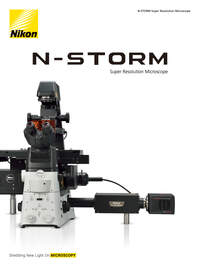- en Change Region
- Global Site
- Home
- Products
- Super-Resolution Microscopes
- N-STORM
The principle of STochastic Optical Reconstruction Microscopy
STochastic Optical Reconstruction Microscopy (STORM) reconstructs a super-resolution image by combining the high-accuracy localization information of individual fluorophores in three dimensions and multiple colors
N-STORM uses stochastic activation of relatively small numbers of fluorophores using very low-intensity light. This random stochastic "activation" of fluorophores allows temporal separation of individual molecules, enabling high precision Gaussian fitting of each fluorophore image in XY. By utilizing special 3D-STORM optics, N-STORM can also localize individual molecules along the Z-axis with high precision. Computationally combining molecular coordinates in three dimensions results in super-resolution 3D images.
High-precision Z-axis position detection
Using a cylindrical lens that asymmetrically condenses light beams in either X or Y direction, Z-axis molecule locations can be determined with an accuracy of about 50 nm. Location in Z is determined by detecting the orientation of the astigmatism-induced stretch in the X or Y direction and the size of the out-of-focus point images. 3D fluorescent images can be reconstructed by combining the determined Z-axis location information with XY-axis location information.

Variety of photoswitchable probes and labeling approaches for high localization accuracy
Various types of activator-reporter pairs and activator-free labels are available. The activator-reporter dye pair approach provides consistent localization accuracy between channels by leveraging the same reporter dye for different channels. Each dye pair consists of an activator dye and reporter dye, with the activator dye regulating the activation state of the reporter dye.
Activator-free labels consist of imaging dye only, enabling simple labeling and sample preparation techniques such as conventional indirect immunofluorescence using conventional dye-conjugated antibodies.




